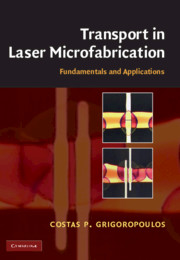Book contents
- Frontmatter
- Contents
- Preface
- 1 Fundamentals of laser energy absorption
- 2 Lasers and optics
- 3 Thermal processes in laser–materials interactions
- 4 Desorption at low laser energy densities
- 5 Dynamics of laser ablation
- 6 Ultrafast-laser interactions with materials
- 7 Laser processing of thin semiconductor films
- 8 Laser-induced surface modification
- 9 Laser processing of organic materials
- 10 Pulsed-laser interaction with liquids
- 11 Laser cleaning of particulate contaminants
- 12 Laser interactions with nanoparticles
- 13 Laser-assisted microprocessing
- 14 Nano-structuring using pulsed laser radiation
- Index
- References
10 - Pulsed-laser interaction with liquids
Published online by Cambridge University Press: 04 December 2009
- Frontmatter
- Contents
- Preface
- 1 Fundamentals of laser energy absorption
- 2 Lasers and optics
- 3 Thermal processes in laser–materials interactions
- 4 Desorption at low laser energy densities
- 5 Dynamics of laser ablation
- 6 Ultrafast-laser interactions with materials
- 7 Laser processing of thin semiconductor films
- 8 Laser-induced surface modification
- 9 Laser processing of organic materials
- 10 Pulsed-laser interaction with liquids
- 11 Laser cleaning of particulate contaminants
- 12 Laser interactions with nanoparticles
- 13 Laser-assisted microprocessing
- 14 Nano-structuring using pulsed laser radiation
- Index
- References
Summary
Rapid vaporization of liquids on a pulsed-laser-heated surface
Background
The laser-beam interaction with materials in liquid environments exhibits unique characteristics in a variety of technical applications. The explosive vaporization of liquids induced by short-pulsed laser irradiation is utilized in laser cleaning to remove micro-contaminants (Park et al., 1994) and in medical laser surgery. Physical understanding of superheated liquids and liquid-to-vapor phase transitions has been sought in order to achieve better control of such applications. The transient development of the bubble-nucleation process and the onset of phase change were monitored by simultaneous application of optical-reflectance and -scattering probes (Yavas et al., 1993). The numerical heat-conduction calculation also shows that the solid surface achieves temperatures of tens of degrees of superheat (Yavas et al., 1994). Real-time measurement of the surface temperature transient in the course of the laser-induced vaporization process is needed, since the surface temperature is an important parameter in heterogeneous nucleation. The kinetics of heterogeneous bubble nucleation and the growth dynamics have long been a subject of intense research interest (Skripov, 1974; Stralen and Cole, 1979; Carey, 1992).
Enhanced pressure is produced in the interaction of short-pulsed laser light with liquids (Sigrist and Kneubühl, 1978). The efficient coupling of laser light into pressure is of interest in many technical and medical areas, such as laser cleaning to remove surface contaminants, laser tissue ablation, corneal sculpturing (Vogel et al., 1990), and gall-stone fragmentation (Teng et al., 1987).
- Type
- Chapter
- Information
- Transport in Laser MicrofabricationFundamentals and Applications, pp. 282 - 312Publisher: Cambridge University PressPrint publication year: 2009



